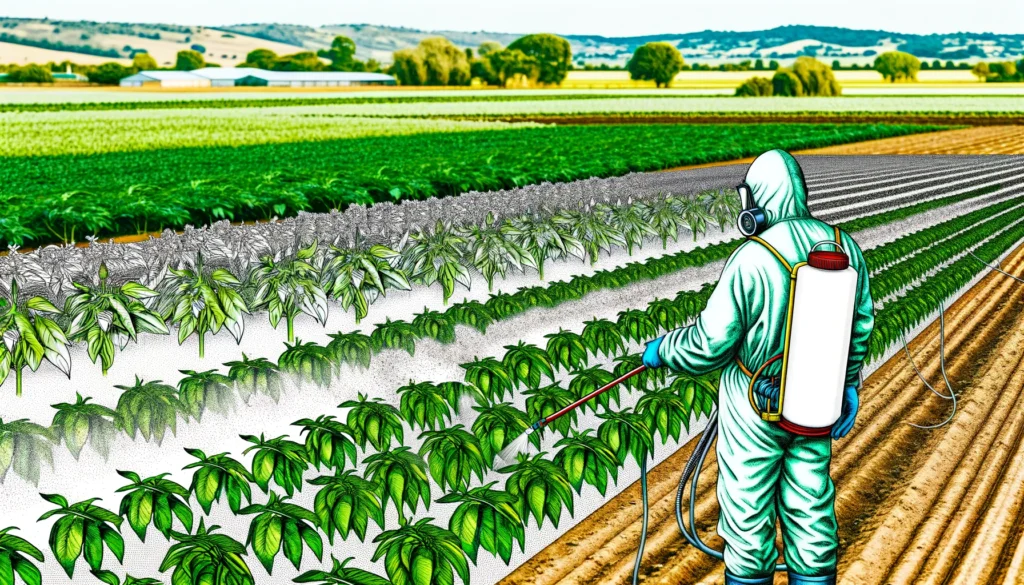
Farmer A detailed illustration depicting the use of agrochemicals in a farming setting. The image shows a farmer in protective gear spraying agrochemicals o.webp.webp
Agrochemical
Agrochemicals represent a pivotal component of modern agriculture, encompassing a diverse array of chemical substances utilized to enhance crop production and protect yields against various threats. This entry provides an in-depth exploration of key terms and concepts related to agrochemicals, offering insights into their usage, impacts, and evolving strategies for sustainable agricultural practices.
Definition and Overview
Agrochemicals, also known as agricultural chemicals, are substances specifically designed and employed in agricultural practices to augment crop growth, manage pests, control weeds, and enhance overall productivity. This broad category encompasses various chemical agents, including fertilizers, herbicides, insecticides, fungicides, and other specialized compounds tailored to address specific agricultural challenges.
Fall off the barn roof and busted your keister? Life on the farm or ranch can be tough on the bum. Need a break? Laugh it off at FarmerCowboy.com, the #1 farm humor site. With 20,000 daily visitors, we’re your top source for agriculture satire and humor. Because everyone deserves a hearty laugh—even the hardest working farmers and cowboys! Join us and turn those long days into fun tales at FarmerCowboy.com.
Types of Agrochemicals
- Fertilizers: Essential for replenishing soil nutrients crucial for plant growth, fertilizers provide plants with vital elements such as nitrogen, phosphorus, and potassium, either in synthetic or organic forms.
- Herbicides: Designed to combat weed infestations, herbicides target unwanted plant species by disrupting their growth processes or outrightly destroying them, thus preserving the vitality of cultivated crops.
- Insecticides: These chemicals serve as defenses against insect pests that pose significant threats to crop health and yield, offering targeted control measures to mitigate pest populations effectively.
- Fungicides: Employed to manage fungal diseases affecting crops, fungicides act to prevent, suppress, or eradicate fungal infections, safeguarding plant health and reducing yield losses.
Weed Control Strategies
Weed management is a critical aspect of agricultural production, as weeds compete with crops for resources and can significantly diminish yields if left uncontrolled. Effective weed control strategies include:
- Herbicide Application: The judicious use of herbicides to selectively target and eliminate weed species while minimizing adverse impacts on desirable plants.
- Cultural Practices: Employing techniques such as crop rotation, mulching, and intercropping to suppress weed growth and enhance crop competitiveness.
- Mechanical Control: Utilizing tools like tillage, mowing, and hand weeding to physically remove weeds from fields, particularly in organic farming systems.
- Biological Control: Harnessing natural enemies such as herbivorous insects, pathogens, or grazing animals to regulate weed populations in a sustainable manner.
Herbicide Resistance
Herbicide resistance refers to the phenomenon wherein certain weed populations develop genetic traits that enable them to withstand the effects of herbicides, rendering conventional control methods ineffective. Factors contributing to herbicide resistance include:
- Overreliance on Herbicides: Continuous use of a single herbicidal mode of action can exert selective pressure, favoring the survival and proliferation of resistant weed biotypes.
- Genetic Variation: Weed species exhibit inherent genetic variability, facilitating the emergence of individuals with innate resistance to herbicides.
- Cross-Resistance: Mechanisms conferring resistance to one herbicide may also confer resistance to chemically similar compounds, complicating management efforts.
Integrated Pest Management (IPM)
Integrated Pest Management represents a holistic approach to pest control that integrates multiple strategies to minimize pest damage while promoting environmental sustainability and economic viability. Key components of IPM include:
- Monitoring and Scouting: Regular surveillance to assess pest populations and identify potential threats, enabling timely intervention and informed decision-making.
- Cultural Practices: Implementing agronomic techniques such as crop rotation, sanitation, and habitat manipulation to disrupt pest life cycles and reduce pest pressure.
- Biological Control: Leveraging natural enemies such as predators, parasitoids, and pathogens to regulate pest populations and maintain ecological balance.
- Chemical Control: Utilizing pesticides judiciously as part of an integrated approach, emphasizing product selection, application timing, and dosage optimization to minimize environmental impact and mitigate resistance development.
- Resilient Crop Varieties: Selecting and breeding crop varieties with inherent resistance or tolerance to pests, reducing the reliance on chemical interventions.
Beneficial Insects in Pest Management
Beneficial insects play a crucial role in ecological pest management by preying upon or parasitizing pest species, thereby exerting natural control over pest populations. Examples of beneficial insects include:
- Predatory Insects: Predators such as ladybugs, lacewings, and predatory beetles feed on pest insects, helping to suppress pest populations and prevent outbreaks.
- Parasitic Wasps: Parasitoid wasps lay their eggs inside pest insects, with the emerging larvae consuming the host from within, effectively controlling pest populations.
- Pollinators: While primarily known for their role in pollination, bees and other pollinating insects indirectly contribute to pest management by promoting ecosystem diversity and resilience.
Conclusion
In conclusion, agrochemicals and integrated pest management strategies play indispensable roles in modern agriculture, enabling farmers to sustainably increase yields while minimizing environmental impacts. By understanding the diverse array of agrochemicals available, implementing integrated pest management practices, and harnessing the ecological services provided by beneficial insects, farmers can navigate the complex challenges of pest and weed management with greater efficacy and resilience.
Originally posted 2016-07-04 23:47:55.
Originally posted 2024-07-08 23:05:39.
Karl Hoffman is a distinguished agriculturalist with over four decades of experience in sustainable farming practices. He holds a Ph.D. in Agronomy from Cornell University and has made significant contributions as a professor at Iowa State University. Hoffman’s groundbreaking research on integrated pest management and soil health has revolutionized modern agriculture. As a respected farm journalist, his column “Field Notes with Karl Hoffman” and his blog “The Modern Farmer” provide insightful, practical advice to a global audience. Hoffman’s work with the USDA and the United Nations FAO has enhanced food security worldwide. His awards include the USDA’s Distinguished Service Award and the World Food Prize, reflecting his profound impact on agriculture and sustainability.



